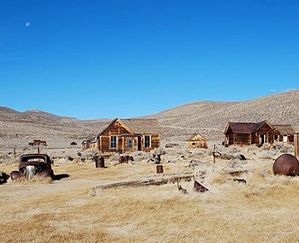Bodie, California Ghost Town

With mines along the western slope of Sierra Nevada almost exhausted, prospective miners moved on to find greener pastures. In 1859, William S. Bodey came across gold at present-day Bodie Bluff. A mill was established in 1861 marking the beginning of significant mining activity in Bodie.
The population rapidly grew from 20 miners to almost 10,000 by 1880.
Bodie became a wild town that rivaled any in the West, with people from all over the country coming to Bodie to take advantage of its riches. The town was full of prostitutes, gunfighters, store owners, miners and robbers. Gambling halls, brothels and opium dens among other amenities also sprung in the town. It also boasted two banks, a school, several churches and three newspapers.
The town developed a bad reputation when crime in the area became rampant with murders occurring almost daily. For whatever reason, Bodie seemed to be a magnet for treacherous people and violent activity.
The Standard Mine and Mill, which was originally known as the Bunker Hill Mine, was quite successful and produced $15 million in gold for over 25years. It was probably this success in returns that prompted a later gold rush to Bodie in 1878.
The winters were particularly harsh on the miners especially in 1878-1879. Due to continued exposure and contraction of winter-related infections, hundreds of miners died. Falling timber into the mines and an explosion of powder magazine made the situation worse. It was a dangerous time to be a miner in Bodie.
The mill was destroyed by fire in 1898, but renovation was completed by the end of the following year. During this period, 30 companies that were producing gold in the area, which realized an estimated total of $90-$100 million in net profits by the time the boom ended.
The mining industry thrived in the 1890’s due to technological advancements. A new cyanide leaching process that could recover gold and silver from low grade ore was invented that renewed interest in many areas including Bodie.
The Standard Mine and Mill also built its own hydroelectric plant that generated electricity to the company’s mill.
As the mines in Bodie became exhausted, people moved elsewhere to look for gold. By 1910, only 688 remained and in 1915, the town was labeled a ghost town for the first time. The Bodie Miner, a newspaper published in Bodie, was last published in 1912. The Standard Consolidated Mine closed in 1914 and the Bodie Railway was abandoned in 1917 and its rails were scrapped. With time, the town was eventually deserted.
In 1962, the ghost town was named a National Historic Landmark and the Bodie State Historic Park was born. It is located about 75 miles southeast of Lake Tahoe, and receives nearly ¼ million visitors each year, making it perhaps the most visited ghost town in the United States.
Other Historic Mining Towns You Should Visit:
The Ghost Town of Bannack, Montana
Historic Silver City, Idaho
The Large Gold Nuggets of Liberty, Washington
The population rapidly grew from 20 miners to almost 10,000 by 1880.
Bodie became a wild town that rivaled any in the West, with people from all over the country coming to Bodie to take advantage of its riches. The town was full of prostitutes, gunfighters, store owners, miners and robbers. Gambling halls, brothels and opium dens among other amenities also sprung in the town. It also boasted two banks, a school, several churches and three newspapers.
The town developed a bad reputation when crime in the area became rampant with murders occurring almost daily. For whatever reason, Bodie seemed to be a magnet for treacherous people and violent activity.
The Standard Mine and Mill, which was originally known as the Bunker Hill Mine, was quite successful and produced $15 million in gold for over 25years. It was probably this success in returns that prompted a later gold rush to Bodie in 1878.
The winters were particularly harsh on the miners especially in 1878-1879. Due to continued exposure and contraction of winter-related infections, hundreds of miners died. Falling timber into the mines and an explosion of powder magazine made the situation worse. It was a dangerous time to be a miner in Bodie.
The mill was destroyed by fire in 1898, but renovation was completed by the end of the following year. During this period, 30 companies that were producing gold in the area, which realized an estimated total of $90-$100 million in net profits by the time the boom ended.
The mining industry thrived in the 1890’s due to technological advancements. A new cyanide leaching process that could recover gold and silver from low grade ore was invented that renewed interest in many areas including Bodie.
The Standard Mine and Mill also built its own hydroelectric plant that generated electricity to the company’s mill.
As the mines in Bodie became exhausted, people moved elsewhere to look for gold. By 1910, only 688 remained and in 1915, the town was labeled a ghost town for the first time. The Bodie Miner, a newspaper published in Bodie, was last published in 1912. The Standard Consolidated Mine closed in 1914 and the Bodie Railway was abandoned in 1917 and its rails were scrapped. With time, the town was eventually deserted.
In 1962, the ghost town was named a National Historic Landmark and the Bodie State Historic Park was born. It is located about 75 miles southeast of Lake Tahoe, and receives nearly ¼ million visitors each year, making it perhaps the most visited ghost town in the United States.
Other Historic Mining Towns You Should Visit:
The Ghost Town of Bannack, Montana
Historic Silver City, Idaho
The Large Gold Nuggets of Liberty, Washington
Highly Recommended Prospecting Books on Amazon:

The Gold Prospector's Field Guide:
A Modern Miner's Handbook for Successfully Finding Gold

Metal Detecting Gold Nuggets:
The Essential Guide to Finding Gold with a Metal Detector

